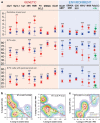Oxidative stress-driven parvalbumin interneuron impairment as a common mechanism in models of schizophrenia
- PMID: 28322275
- PMCID: PMC5491690
- DOI: 10.1038/mp.2017.47
Oxidative stress-driven parvalbumin interneuron impairment as a common mechanism in models of schizophrenia
Abstract
Parvalbumin inhibitory interneurons (PVIs) are crucial for maintaining proper excitatory/inhibitory balance and high-frequency neuronal synchronization. Their activity supports critical developmental trajectories, sensory and cognitive processing, and social behavior. Despite heterogeneity in the etiology across schizophrenia and autism spectrum disorder, PVI circuits are altered in these psychiatric disorders. Identifying mechanism(s) underlying PVI deficits is essential to establish treatments targeting in particular cognition. On the basis of published and new data, we propose oxidative stress as a common pathological mechanism leading to PVI impairment in schizophrenia and some forms of autism. A series of animal models carrying genetic and/or environmental risks relevant to diverse etiological aspects of these disorders show PVI deficits to be all accompanied by oxidative stress in the anterior cingulate cortex. Specifically, oxidative stress is negatively correlated with the integrity of PVIs and the extracellular perineuronal net enwrapping these interneurons. Oxidative stress may result from dysregulation of systems typically affected in schizophrenia, including glutamatergic, dopaminergic, immune and antioxidant signaling. As convergent end point, redox dysregulation has successfully been targeted to protect PVIs with antioxidants/redox regulators across several animal models. This opens up new perspectives for the use of antioxidant treatments to be applied to at-risk individuals, in close temporal proximity to environmental impacts known to induce oxidative stress.
Conflict of interest statement
MD is employed by Lundbeck A/S, LL is employed by F. Hoffmann-La Roche and PD is employed by Pfizer. J-HC received funding from Hoffmann-La Rochet to cover material, technical costs and confocal microscopy fees for the Fmr1 KO study. The remaining authors declare no conflict of interest.
Figures


Similar articles
-
A lack of GluN2A-containing NMDA receptors confers a vulnerability to redox dysregulation: Consequences on parvalbumin interneurons, and their perineuronal nets.Neurobiol Dis. 2018 Jan;109(Pt A):64-75. doi: 10.1016/j.nbd.2017.10.006. Epub 2017 Oct 10. Neurobiol Dis. 2018. PMID: 29024713
-
Early-life insults impair parvalbumin interneurons via oxidative stress: reversal by N-acetylcysteine.Biol Psychiatry. 2013 Mar 15;73(6):574-82. doi: 10.1016/j.biopsych.2012.09.020. Epub 2012 Nov 7. Biol Psychiatry. 2013. PMID: 23140664
-
Perineuronal nets protect fast-spiking interneurons against oxidative stress.Proc Natl Acad Sci U S A. 2013 May 28;110(22):9130-5. doi: 10.1073/pnas.1300454110. Epub 2013 May 13. Proc Natl Acad Sci U S A. 2013. PMID: 23671099 Free PMC article.
-
Perineuronal Nets and Metal Cation Concentrations in the Microenvironments of Fast-Spiking, Parvalbumin-Expressing GABAergic Interneurons: Relevance to Neurodevelopment and Neurodevelopmental Disorders.Biomolecules. 2021 Aug 18;11(8):1235. doi: 10.3390/biom11081235. Biomolecules. 2021. PMID: 34439901 Free PMC article. Review.
-
Redox dysregulation, neuroinflammation, and NMDA receptor hypofunction: A "central hub" in schizophrenia pathophysiology?Schizophr Res. 2016 Sep;176(1):41-51. doi: 10.1016/j.schres.2014.06.021. Epub 2014 Jul 5. Schizophr Res. 2016. PMID: 25000913 Free PMC article. Review.
Cited by
-
Impact of Perineuronal Nets on Electrophysiology of Parvalbumin Interneurons, Principal Neurons, and Brain Oscillations: A Review.Front Synaptic Neurosci. 2021 May 10;13:673210. doi: 10.3389/fnsyn.2021.673210. eCollection 2021. Front Synaptic Neurosci. 2021. PMID: 34040511 Free PMC article.
-
Parvalbumin interneuron loss mediates repeated anesthesia-induced memory deficits in mice.J Clin Invest. 2023 Jan 17;133(2):e159344. doi: 10.1172/JCI159344. J Clin Invest. 2023. PMID: 36394958 Free PMC article.
-
Parvalbumin interneuron vulnerability and brain disorders.Neuropsychopharmacology. 2021 Jan;46(2):279-287. doi: 10.1038/s41386-020-0778-9. Epub 2020 Jul 28. Neuropsychopharmacology. 2021. PMID: 32722660 Free PMC article. Review.
-
Increase in Seizure Susceptibility After Repetitive Concussion Results from Oxidative Stress, Parvalbumin-Positive Interneuron Dysfunction and Biphasic Increases in Glutamate/GABA Ratio.Cereb Cortex. 2020 Nov 3;30(12):6108-6120. doi: 10.1093/cercor/bhaa157. Cereb Cortex. 2020. PMID: 32676666 Free PMC article.
-
Apocynin-Tandospirone Derivatives Suppress Methamphetamine-Induced Hyperlocomotion in Rats with Neonatal Exposure to Dizocilpine.J Pers Med. 2022 Feb 27;12(3):366. doi: 10.3390/jpm12030366. J Pers Med. 2022. PMID: 35330366 Free PMC article.
References
-
- Hu H, Gan J, Jonas P. Interneurons. Fast-spiking, parvalbumin(+) GABAergic interneurons: from cellular design to microcircuit function. Science 2014; 345: 1255263. - PubMed
-
- Savitz JB, Price JL, Drevets WC. Neuropathological and neuromorphometric abnormalities in bipolar disorder: view from the medial prefrontal cortical network. Neurosci Biobehav Rev 2014; 42: 132–147. - PubMed
Publication types
MeSH terms
Substances
Grants and funding
LinkOut - more resources
Full Text Sources
Other Literature Sources
Research Materials

